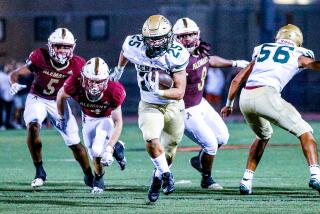Feet don’t stop
- Share via
ON a Hollywood Bowl program of jazz-influenced music for dance, tap virtuoso Savion Glover set an awesome standard of perpetual motion Sunday, a stamina-testing bravura display that set him constantly aquiver from the top of his dreadlock pompadour down to the gleaming cleats on his lime-green tap shoes.
Tapping with his jazz quartet on the first half of the program and with (sometimes against) the Hollywood Bowl Orchestra after intermission, Glover danced on a square, miked tap platform at the center of the forestage, enhanced by amplification and television screens, of course, but a force field in his own right. As always, his distinctively rough-edged, heavy-hitting style served musical rather than visual priorities: tapping as drumming. But he did include a few flash steps (tapping while balanced on the tips of his toes, for instance) missing in his periodic Southland appearances during the last few years.
With the input of jazzmen Tommy James, Dwayne “Cook” Broadnax, Patience Higgins and Andy McCloud, the music and tap became an extended improvisational collaboration tinged with themes by Sousa: a collaboration untitled here but something Glover and company have called “Stars and Stripes Forever -- For Now” in previous local engagements.
Besides falling into complex marching patterns that suited Sousa splendidly, Glover delivered high-pressure, no-nonsense rhythmic explorations that suddenly terminated or switched to playful, loose, even goofy tapping or an easygoing nightclub style or a chugging, insistent, driving foray accented with a sudden scrape of the toe or a slam on the side of the foot. All of it happened virtually on the same spot and with only a few turns to vary the look of the dancing. His interplay with Broadnax proved especially intriguing -- Glover’s feet playing the role of bass drum, Broadnax contributing a higher, lighter style of percussion.
With Bramwell Tovey conducting the Hollywood Bowl Orchestra, Glover’s focus became adding a tap obbligato to five sections from Duke Ellington’s 1970 symphonic ballet score “The River,” a task something like his “Classical Savion” experiments with a chamber orchestra.
Here sound imbalances left three of the sections hopelessly clattered up by the tapping: the mood and flow of the music stomped to smithereens. But the “Giggling Rapids” and “Vortex” sections (the latter repeated as an encore) were brilliant, the footwork sometimes decorating the musical line, sometimes providing a kind of engine underneath it, but also fusing with it here and there, as if Glover and Ellington were on exactly the same wavelength.
It certainly helped that Tovey is a jazz pianist as well as a conductor, for shifts between classical and popular idioms abound in “The River” and Ellington’s “Night Creature” (heard earlier on the program, without any tap component). Begun in 1955 and revised eight years later, “Night Creature” found Tovey marshaling impressively sweeping symphonic transitions along with potent contributions by jazz saxophones, courtesy of the Hollywood Bowl Big Band.
Tovey’s own showpiece arrangements of “America” and the dance-at-the-gym mambo from Leonard Bernstein’s dance musical “West Side Story” (1957) had all manner of surprises and details but came off as excessively raw and even threatening -- though much better played than in another orchestration under another conductor on the Bowl’s opening night this season.
Finally, Richard Rodgers’ 1936 Broadway ballet “Slaughter on Tenth Avenue” had great lightness of touch in the intimate and Gershwin-esque passages, though Tovey may have been too much enraptured by the work’s swoony love theme for ideal forward momentum.
Soloists from the Bowl Orchestra demonstrated their versatility, with concertmaster Bruce Dukov making a strong case for contemporary lyricism in the classical/jazz byplay of “Night Creature.”
More to Read
The biggest entertainment stories
Get our big stories about Hollywood, film, television, music, arts, culture and more right in your inbox as soon as they publish.
You may occasionally receive promotional content from the Los Angeles Times.








